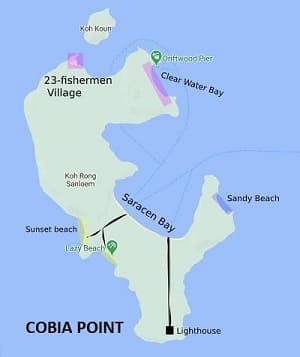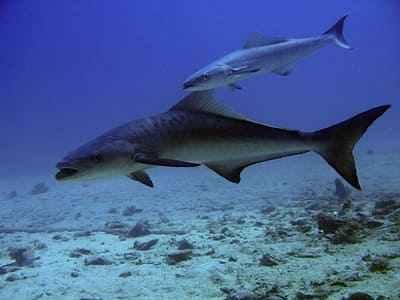Home › Sea Life › Marine Animals › Vertebrates › Cobia Fish
Cobia Fish Facts and Information
[Phylum: Chordata] [Class: Actinopterygii (bony-fish)] [Order: Carangiformes] [Family: Rachycentridae]
Cobias are large, fearless, predatory marine fish found in tropical and subtropical saltwater oceans - usually near to coastline structures (e.g. harbours, piers, sunken wrecks).
This section contains everything scuba divers need to know about the cobia fish species (also called black kingfish) with a few extra fun facts and images.
Appearance and Characteristics of Cobias
The taxonomic order of the Cobia fish species is Carangiformes and its scientific name is Rachycentron canadum.
It is the only surviving member of the Rachycentridae family and there are no subspecies.
There are several distinguishing characteristics that scuba divers use to identify these perciform marine fish, including:
- An elongated, torpedo-shaped body with dark brown (or black) scales.
- Wide silver-grey pale coloured stripes on the back and underbelly.
Important: It is common for divers to mistake cobia for their closest living relatives, remoras (family Echeneidae) and sometimes for grey reef sharks (family Carcharhinidae).
How Big Do Cobia Fish Get?
Having a wide, flat head and a dorsal fin with short, sharp, isolated spines makes them a little easier to recognise. But, you should also use their overall size and shape for confirmation.
The largest and heaviest specimens (females) can reach a length of two metres (almost 7 feet long). Even so, it is more commonplace to see sizes around one metre long - such as at one of our favourite destinations, the vertical wall at Cobia Point dive site at Koh Rong Samloem, Cambodia.
In fact, fully matured adults can weigh around sixty (60) kilos (130 pounds). Despite this, the anal fin is relatively small with a rounded, half-moon shaped tail fin.
Cobia juveniles display dark lateral bands, which tend to fade as they mature. Most of the fins on young species are brown, but you may see grey markings on their anal and pelvic fins.
Note: One of the most distinguishing characteristics of the cobia fish is its protruding lower jaw. They have bands of villiform teeth (elongated fine teeth used for stabbing) on their lips, tongue, and roof of the mouth.
Cobia Habitat and Distribution
Because cobia are pelagic fish (live in the open sea) they thrive best in the coastal regions of the Atlantic, Indian, and Pacific Oceans.
Even so, divers often find them congregating in small groups in select areas of the world's best dive sites, such as Florida and Mexico.
 Species that live off the coast of south Florida will migrate further north along the Atlantic coast in early Spring.
Species that live off the coast of south Florida will migrate further north along the Atlantic coast in early Spring.
They are natural hunters that seek refuge around underwater structures that obstruct the normal flow of the open sea, such as:
- Anchored vessels
- Fixed buoy lines and pilings
- Offshore coral reefs
- Rocky outcrops
- Shallow water wrecks
Cobia also range inshore and you may find them hunting in shallow bays, estuaries, inlets, and around mangroves.
What Do Cobias Eat?
Accurate swim speeds for the cobia fish species remain unrecorded. Nonetheless, these opportunistic hunters are fast swimmers and extremely efficient predators.
They are carnivores with specific feeding habits, such as preying on other small sea creatures. Even so, they also shadow other large predators (e.g. manta rays and pelagic shark species) to feed on any scraps left behind after the catch.
Like most sea life creatures and marine species, cobias have favourite foods that they like to prey on. Thus, their standard diet will include:
- Atlantic menhaden (Brevoortia tyrannus)
- Crab (especially the Chesapeake blue crab)
- Crustaceans (e.g. mantis shrimp)
- Hydroids
- Seahorses
- Small fish
- Squid
- Stargazers (scientific name: Uranoscopidae)
Note: Now you may be wondering what eats cobia fish. The main predator of adult specimens is the shortfin mako shark. Whereas, the mahi-mahi (common dolphinfish) will prey on vulnerable juvenile cobia for food.
Cobia Fish Behaviour and Reproduction
How Do Cobias Communicate?
Like most fish families, they communicate with one another through a combination of a sense of smell, movement, sound, and colour.
In the main, they are harmless, solitary creatures. But, scuba divers will often see small groups swimming around an anchored dive boat during the breeding season (e.g. grouping together to spawn).
This is a phase when their typical coloration changes - from dark brown to light, horizontal stripes. The eggs of the female, and the sperm from the male, mix outside of the body and float in the water column - with regular blooms of plankton.
Here's the cool part:
Egg hatching occurs two to three days after fertilisation. It then takes around five days for 'buoyant' larvae to open their eyes and mouth.
 As you may expect, the largest females will produce the most eggs during the reproductive process. An average litter size is many thousands of eggs.
As you may expect, the largest females will produce the most eggs during the reproductive process. An average litter size is many thousands of eggs.
Two years later, most of the young will have reached sexual maturity.
When compared to other ray-finned fish, such as the lionfish life cycle, cobias enjoy a lengthy lifespan - up to fifteen (15) years.
The three main threats to the survival of the cobia population are sharks, mahi-mahi, and humans (through overfishing).
Its soft texture and buttery flavour fetches a high price from commercial buyers who sell it fresh, frozen, or smoked.
Note: The International Union of Conservation of Nature (IUCN) considers the status of cobia as being of 'Least Concern'. Any potential threat to their existence could come from overfishing in certain countries.
Interesting Facts about Cobia
The following information enhances the cobia fish species facts guide with short snippets of unfamiliar data and educational research.
- The cobia fish is content at being the host for certain parasites, including copepods, nematodes, and trematodes (parasitic flatworms called flukes).
- Like sharks and rays, cobias do not have a swim bladder to control their depth.
- Even though there is no sucker on top of a cobia's head, the remora species (also called suckerfish) is a close relative. But, it is the only extant (surviving) member in its family Rachycentridae, and genus Rachycentron.
- Despite being found in most warm oceans, they do not exist on the Pacific Coast of North America.
- Cobias will tolerate a wide range of salinity (concentrations of salts) and extreme water temperatures.
- There is a long list of common names used to describe this fish in different areas, including:
- Black bonito
- Black kingfish
- Black salmon
- Cabio
- Crabeater
- Cubby yew
- Lemonfish
- Ling
- Prodigal son
- Runner
- Sergeant Fish
- Some people pay a high price for its meat. In fact, cobia culture (also called aquaculture) is a growing activity in some parts of the world. They raise the fish in offshore farms and then sell them to market around eighteen months later.
- Yes... it is safe to eat cobia meat. It can be expensive in some countries. But, connoisseurs enjoy its smooth, buttery taste. Some experts say it's perfect for use in certain types of exotic food recipes.
Related Information and Help Guides
- 10 Examples of Marine Vertebrates for Beginners
- Bull Sharks Facts and Information with Pictures
- Grouper Fish Species Description and Characteristics
- List of Reasons Why Divers Should Not Feed Fish
- Where is a Good Dive Site to See Cobia Fish Species?
Note: Like most animals, cobias will try to defend themselves if something (or someone) is provoking or threatening it. But, in general they will not harm scuba divers. They will thrash around with dangerous tail motions during a catch (e.g. when deep sea fishing in Thailand).